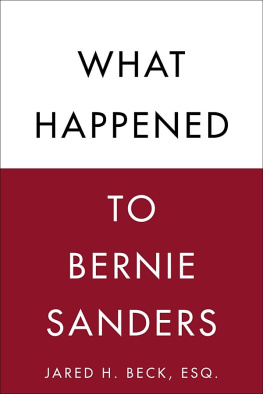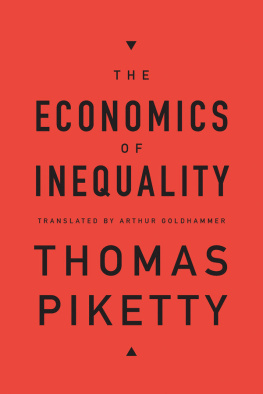
ENCOUNTER BROADSIDES Inaugurated in the fall of 2009, Encounter Broadsides are a series of timely pamphlets and e-books from Encounter Books. Uniting an 18th century sense of public urgency and rhetorical wit (think The Federalist Papers, Common Sense) with 21st century technology and channels of distribution, Encounter Broadsides offer indispensable ammunition for intelligent debate on the critical issues of our time. Written with passion by some of our most authoritative authors, Encounter Broadsides make the case for ordered liberty and the institutions of democratic capitalism at a time when they are under siege from the resurgence of collectivist sentiment. Read them in a sitting and come away knowing the best we can hope for and the worst we must fear.

H ILLARY CLINTON launched her presidential campaign in spring 2015 by venturing from New York to Iowa to rail against income inequality and to propose new spending programs and higher taxes on the wealthy as remedies for it. She re-emphasized these dual themes of inequality and redistribution in the relaunch of her campaign in June 2015 and in the occasional campaign speeches she delivered over the course of the summer. Clintons campaign strategy has been interpreted as a concession to influential progressive spokesmen like Senators Elizabeth Warren and Bernie Sanders, who have loudly pressed these redistributionist themes for several years, in response to the financial meltdown in 2008 and out of a long-standing wish to reverse the Reagan Revolution of the 1980s. In view of Clintons embrace of the progressive agenda, there can be little doubt that inequality, higher taxes, and proposals for new spending programs will be central themes in the Democratic presidential campaign in 2016.

While voters are worried about inequality, they are far more skeptical of the capacity of the government to do anything about it without making matters worse for everyone.

The intellectual case for redistribution has been outlined in impressive detail in recent years by a phalanx of progressive economists including Thomas Piketty, Joseph Stiglitz, and New York Times opinion columnist Paul Krugman who have called for redistributive tax and spending policies to address the challenge of the growth of inequalities in income and wealth. Pikettys best-selling book, Capital in the Twenty-First Century (2014), made a case for raising the top marginal tax rate in the United States from 39.6 percent (where it stands today) to 80 percent or more (where it was during the 1940s and 1950s), and then relying upon the U.S. government to redistribute those funds from the wealthy to households in greater need of them. Nobel Laureate Robert Solow of MIT put the matter bluntly in a 2014 exchange with Harvards Gregory Mankiw, saying that he is in favor of dealing with inequality by taking a dollar from a random rich person and giving it to a random poor person, presumably with the federal government acting as the middleman to implement the transaction.
Public-opinion polls over the years have consistently shown that voters overwhelmingly reject programs of redistribution in favor of policies designed to promote overall economic growth and job creation. More-recent polls suggest that while voters are increasingly concerned about inequality and question the high salaries paid to executives and bankers, they nevertheless reject redistributive remedies like higher taxes on the wealthy. According to those studies, voters do not support redistributive policies because they do not believe the government is capable of implementing them in effective ways. While voters are worried about inequality, they are far more skeptical of the capacity of the government to do anything about it without making matters worse for everyone.
Here, as is often the case, there is more wisdom in the publics outlook than in the campaign speeches of Democratic presidential candidates and in the books and opinion columns of progressive economists. Leaving aside the morality of redistribution, the progressive case is based upon a significant fallacy: it assumes that the U.S. government is actually capable of redistributing income from the wealthy to the poor. For reasons of policy, tradition, and institutional design, this is not the case. Whatever one may think of inequality, redistributive fiscal policies are unlikely to do much to reduce it, a point that the voters seem instinctively to understand.
* * *
One need only look at the effects of federal tax and spending policies over the past 3 decades to see that this is so. The chart on page 7, based upon data compiled by the Congressional Budget Office (CBO), displays the national shares of before- and after-tax income for the top 1 percent and 10 percent of the income distribution from 1979 to 2011, along with the same figures for the bottom quintile of the distribution. For purposes of this study, the CBO defined income as market income plus government transfers, including cash payments and the value of in-kind services and payments, such as health care (Medicare and Medicaid) and food stamps. The chart thus represents a comprehensive portrait of the degree to which federal tax and spending policies redistribute income from the wealthiest to the poorest groups, and to households in between.
The chart illustrates two broad points. First, the wealthiest groups gradually increased their share of national income (both in pre- and after-tax and transfer income) over this 30-plus-year period; and second, federal tax and spending policies had little effect on the overall distribution of income.
Across this period, the top 1 percent of the income distribution nearly doubled their share of (pretax) national income, from about 9 percent in 1979 to more than 18 percent in 2007 and 2008, before it fell back after the financial crisis, to 15 percent in 2010 and 2011. (Some studies suggest that by 2014, it was back up to 18 percent.) Meanwhile, the top 10 percent of the income distribution increased their share by a third, from about 30 percent in 1979 to 40 percent in 2007 and 2008, before it fell to 37 percent in 2011. This was a secular trend in the distribution of national income that persisted throughout different presidential administrations and tax regimes. The path was smoothly upward for both income groups across the period, with temporary peaks and troughs corresponding with business-cycle rallies and recessions. Economists have offered different theories to explain the trend, though most agree that the causes lie in several overlapping factors, including globalization, technological change, record stock-market gains, and increasing premiums paid to highly educated workers.

Many will be surprised to learn that the federal fiscal system taxes and spending does not do more to reduce inequalities in income that arise from the free-market system. After all, the progressive income tax was designed to redistribute income by placing heavier burdens on the wealthy, and many federal spending programs were crafted specifically to assist lower-income households. Yet there are perfectly obvious reasons, on both the tax and spending sides, as to why redistribution does not succeed in the American system and probably cannot be made to succeed.
Next page













